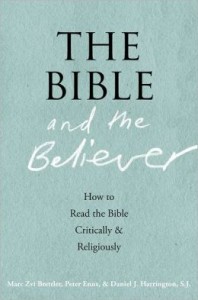 LDS talk a lot about reading the scriptures but not so much about how to read them or the different ways they can be read. This is the first of five posts on how to read the Bible or how to practice the art of biblical interpretation. I will be going through some of the material in The Bible and the Believer: How to Read the Bible Critically and Religiously (OUP, 2012). The book is written by three biblical scholars: Marc Zvi Brettler (Jewish), Peter Enns (Protestant), and Daniel J. Harrington (Catholic). Each one wrote a chapter showing how those within their faith tradition have read and now read the Bible both critically and religiously. The other two scholars then give short responses. It is a productive exchange. After this introductory post, I plan to cover those three chapters, giving a Jewish, Catholic, and Protestant view of reading the Bible, in posts two through four, then a fifth post that draws on those views, plus LDS ideas, to talk about LDS approaches to reading and interpreting the Bible.
LDS talk a lot about reading the scriptures but not so much about how to read them or the different ways they can be read. This is the first of five posts on how to read the Bible or how to practice the art of biblical interpretation. I will be going through some of the material in The Bible and the Believer: How to Read the Bible Critically and Religiously (OUP, 2012). The book is written by three biblical scholars: Marc Zvi Brettler (Jewish), Peter Enns (Protestant), and Daniel J. Harrington (Catholic). Each one wrote a chapter showing how those within their faith tradition have read and now read the Bible both critically and religiously. The other two scholars then give short responses. It is a productive exchange. After this introductory post, I plan to cover those three chapters, giving a Jewish, Catholic, and Protestant view of reading the Bible, in posts two through four, then a fifth post that draws on those views, plus LDS ideas, to talk about LDS approaches to reading and interpreting the Bible.
Why should a Mormon read this book? What’s wrong with just picking up the Bible and reading Luke or Deuteronomy or Ecclesiastes? First, for an LDS reader, the book (or others like it) shows a wider spectrum of legitimate ways of reading and interpreting the Bible. It is helpful to see that tough issues we often address within the LDS context are often shared by other denominations and faiths. Not all of our issues are *our* issues — some of them we share with other believers. Second, the book helps the LDS reader reflect on how Mormons generally read and interpret the Bible, and how we as individual Mormons (or Catholics or Jews or whatever) might improve our own approach to reading and understanding.
The book opens with an 18-page introduction written jointly by all three authors. They make several basic points about historical criticism (aka biblical criticism, higher criticism, or the historical-critical method) and about biblical interpretation that set the stage for the individual chapters to follow.
- The authors define historical criticism as “the process of establishing the original, contextual meaning of biblical texts and assessing their historical accuracy,” which is “an indispensable step in biblical interpretation.”
- “Historical criticism assumes that the biblical text can be read as any ancient text is read, that is, without any special presuppositions concerning what its words mean and how it should be interpreted.” So, using “the tools of language and reason,” one tries to “read the ancient text in its ancient historical context and to discern its original meaning” in the light of “its language and images, literary form, structures, and message to its original authors, hearers, or readers.”
- Biblical interpretation is modeled within the Bible itself: Jeremiah and the later chapters of Isaiah use and adapt themes from First Isaiah; Chronicles reworks material in Samuel and Kings for a post-exilic audience. In later years, the Dead Sea scrolls, the New Testament, Josephus, and Philo all exhibit variations on reading and interpreting earlier Jewish scripture in light of their own historical context.
But historical criticism is not the end of the scriptural inquiry. There is not generally one true historically critical reading of a book or text. Criticism rejects or cast doubt on some readings but supports others, which are then available for different religious readings of a text or a better literary reading of the text. As expressed by the authors, “we are convinced that it is possible to read the Bible both critically and religiously.” They rather optimistically state, “Whatever challenges such [historical critical] study raises for religious belief are brought into conversation with religious tradition rather than deemed grounds for dismissing either that tradition or biblical criticism.”
The hope is that such a process works for LDS tradition as well as for Jewish, Catholic, and Protestant tradition. In other words, that whatever challenges such historical critical study raises for LDS religious belief can be brought into conversation with LDS religious tradition rather than deemed grounds for dismissing either that tradition or historical criticism. And there are hopeful signs just recently that such an attempt is timely, such as the new initiative at Gospel Topics (at LDS.org) and the upcoming BYU New Testament Commentary. Any other hopeful signs? Any other books you have read that help to bridge the divide between critical and religious readings of scripture?